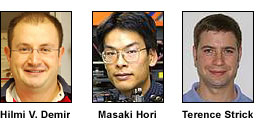
EURYI Winners Announced
STRASBOURG, France, Sept. 24, 2007 -- Researchers with big plans for molecular optoelectronic nanodevices, antimatter and biological nanomachines are among the 20 winners of the European Young Investigator (EURYI) awards for 2007.
 The awards are bestowed through scientific peer review and designed to help outstanding young scientists create teams at research centers in Europe. This year's winners will be based in the Czech Republic, France, Germany, Netherlands, Poland, Sweden, Switzerland and Turkey. The award includes prizes ranging from €1 million (approximately $1.4 million) to €1.25 million (about $1.7 million).
The awards are bestowed through scientific peer review and designed to help outstanding young scientists create teams at research centers in Europe. This year's winners will be based in the Czech Republic, France, Germany, Netherlands, Poland, Sweden, Switzerland and Turkey. The award includes prizes ranging from €1 million (approximately $1.4 million) to €1.25 million (about $1.7 million).
The 2007 winners are the youngest group in EURYI's four-year history, with an average age of 33 (compared to last year's 35), this year is also distinctive for having the most women awardees -- six.
"I am particularly proud of the selection this year, as we see more female researchers included. It is also with mixed feeling to acknowledge this would be the last EURYI awards, at least in its present form, that will be co-organized by EuroHORCs (European Heads of Research Councils) and the ESF. The future for this type of award will now be determined by the European Commission's ERC (European Research Council) Starting Investigator Research Grant scheme," said John Marks, chief executive of the ESF.
This year's winners include: Hilmi Volkan Demir, assistant professor of physics and electrical engineering and associate director of the Nanotechnology Research Center at Bilkent University in Ankara, Turkey; Masaki Hori of the Max Planck Institute of Quantum Optics in Garching, Germany, who is currently a postdoctoral research fellow at the University of Tokyo; Maciej Wojtkowski, an assistant professor at the Institute of Physics of Nicolaus Copernicus University in Poland; and Terence Strick, principle investigator at CNRS (the National Center for Scientific Research in France) and the Institute Jacques Monod in Paris.
Demir and his group have developed hybrid nanophotonic devices that incorporate different types of nanostructures for applications in lighting, imaging, sensing, and communications in the ultraviolet-visible-infrared range of the spectrum. With his award, Demir aims to develop a novel class of molecular-scale hybrid optoelectronic nanodevices that use semiconducting, conducting, and insulating nanoparticles and molecules integrated on microscale chips through different hybridization techniques. The goal is to demonstrate the first truly molecular optoelectronic devices that can be controlled and constructed at the nanoscale and that outperform microsized devices.
Physicists want to study antimatter much more closely and confirm that it really is the exact opposite of normal matter, but antimatter is very difficult to make and even harder to store. The moment it comes into contact with normal matter it annihilates within a trillionth of second, so it has to be isolated and manipulated indirectly. Until now this has only been possible in large expensive apparatus using electric or magnetic fields to contain the antimatter.
Hori, who also won the Inoue prize for young researchers in 2003, aims to break new ground in handling and storing antimatter by using radio frequency, not magnetic fields, to store subatomic particles called antiprotons. These are thought to be the exact opposite of the protons within the nucleus of every atom, having negative rather than positive charge.
His device, a "superconducting radio-frequency quadrupole trap," will be about the size of an office wastebasket. Hori then plans to use the device to create new complete atoms of antimatter and then conduct experiments that prove they really do behave as physicists have predicted. Antimatter is also of interest for applications such as medical diagnosis, and is already used in PET (positron emission tomography) scanners.
Wojtkowski's objective is to develop novel optical imaging methods based on optical coherence tomography that could analyze the posterior and anterior segments of the eye in clinical conditions. He and his team believe these methods could improve the sensitivity of diagnostic tests and might be useful to assess early structural and functional changes in the eye associated with retinal disease and glaucoma. The results of their project could have widespread research and clinical applications in ophthalmology.
Strick proposes using single-molecule nanomanipulation and single-molecule fluorescence imaging techniques to simultaneously measure structural and kinetic properties of biological "molecular motors." His work is expected to provide mechanistic insight into these fundamental biological machines, exposing their kinetic "Achilles' heel" for applications such as drug discovery.
The EURYI Awards, first presented in 2003, were developed by the EuroHORCS in collaboration with the ESF in Strasbourg to attract talented young researchers worldwide and lead to scientific advancements in Europe. ESF's role in EURYI is supported by funds from the European Commission's Framework Programme 6.
The 2007 recipients will receive their award, presented by Nobel laureate Tim Hunt, at a ceremony Thursday in Helsinki, Finland.
For more information, visit: www.esf.org/activities/euryi/awards/2007.html
Published: September 2007